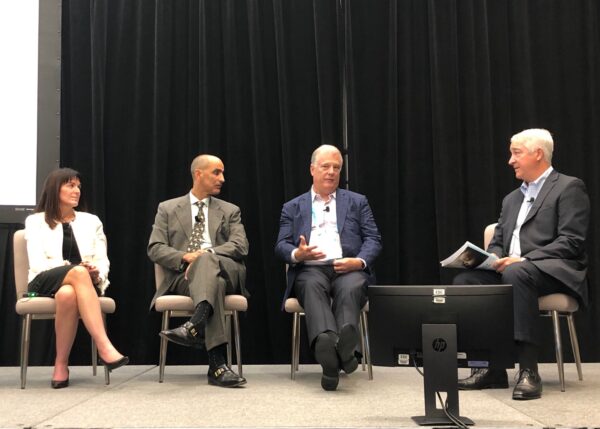
Susan Morano, J&J Medical Devices Corporate Development, Charlie Attlan, Boston Scientific Corporate Development, Christopher Cleary, Medtronic Corporate Development, with John Babitt of E&Y at the MedTech Conference in Boston.
It used to be that large, strategic buyers like Johnson & Johnson, Medtronic and Boston Scientific could have their cake and eat it too when it came time to buy a young startup.
Those days are gone, at least according to Charlie Attlan, senior vice president, corporate strategy and business development at Boston Scientific. At a panel on startup medtech valuations on the second day of the MedTech conference hosted by AdvaMed, the industry’s largest lobby, Attlan explained that what has changed is the potential for startups to go public.
“Five years ago or certainly 10 years ago when I started [at Boston Scientific] we were oftentimes in a lot of our deals, we were the only exit and we negotiated as a buyer from a position of real strength,” he said. “Oftentimes we were alone in the process or defacto alone – there’s always a threat of competition that the seller tries to project, but you have a good sense of when you are effectively alone. So that helps on valuation. In the last year and a half, all bets are off.”
Attlan went on to say that Boston Scientific has passed on a “number of deals” because those startups had an alternative to M&A.
“They have credibly pulled out the IPO threat and that’s new and I don’t know how long that lasts,” he said. “That’s great for sellers because they have an additional exit. For the first time that I remember and this doesn’t make much sense to me but IPO values are higher than M&A values. So you have this weird dynamic where equity comps are higher than M&A comps which, for all of you who are in banking and valuations, that’s the opposite of what you are used to.”
Attlan went on to explain that the multiple of revenue that a strategic company pays a startup is usually higher than what is available through the public markets.
“They are higher by definition because the strategic has synergies and therefore a strategic buyer pays a premium over a public company value,” he said. “Today …when you look at the multiple of M&A deals, they are lower multiples of revenue than the multiples at which a public company trades on the public markets. So that creates a real difficulty.”
That’s because the large corporations are not going to pay 15 times the revenue when the public market multiple is 12 times revenue already, he noted.
“I am making up these numbers,” Attlan later clarified.
Christopher Cleary, vice president of corporate development at Medtronic, summed it up colorfully:
“You create a movie and the ball field is turned upside down, dogs and cats are living together, total chaos,” he declared as the audience broke into laughter.
John Babitt, partner at E&Y and the moderator of the panel, produced the real numbers behind the discussion.
“The public high-growth company multiples are at 8.8 … and the takeout multiples are now approaching four,” Babitt said, noting they are slightly better data than dogs and cats.
Broadly, Cleary, Attlan and Susan Morano, VP of business development of the medical devices group, at Johnson & Johnson, were discussing valuations and the importance of M&A to each of the company’s growth strategies.
So who is the most prolific acquirer in 2018? Here is a chart courtesy of Piper Jaffray that was shared on the panel and the answer might be surprising.
Editor’s Note: The story has been updated with the chart from Piper Jaffray.
Photo: Arundhati Parmar, MedCity News













